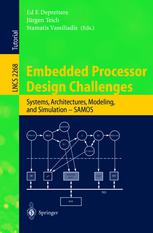

Most ebook files are in PDF format, so you can easily read them using various software such as Foxit Reader or directly on the Google Chrome browser.
Some ebook files are released by publishers in other formats such as .awz, .mobi, .epub, .fb2, etc. You may need to install specific software to read these formats on mobile/PC, such as Calibre.
Please read the tutorial at this link: https://ebookbell.com/faq
We offer FREE conversion to the popular formats you request; however, this may take some time. Therefore, right after payment, please email us, and we will try to provide the service as quickly as possible.
For some exceptional file formats or broken links (if any), please refrain from opening any disputes. Instead, email us first, and we will try to assist within a maximum of 6 hours.
EbookBell Team

5.0
98 reviewsThis textbook is intended to give an introduction to and an overview of sta- of-the-art techniques in the design of complex embedded systems. The book title is SAMOS for two major reasons. First, it tries to focus on the actual distinct, yet important problem ?elds of System-Level design of embedded systems, including mapping techniques and synthesis,Architectural design,Modeling issues such as speci?cation languages, formal models, and- nallySimulation. The second reason is that the volume includes a number of papers presented at a workshop with the same name on the Island of Samos, Greece, in July 2001. In order to receive international attention, a number of reputed researchers were invited to this workshop to present their current work. Participation was by invitation only. For the volume presented here, a number of additional papers where selected based on a call for papers. All contributions were refereed. This volume presents a selection of 18 of the refereed papers, including 2 invited papers. The textbook is organized according to four topics: The ?rst isA)System- LevelDesignandSimulation.Inthissection,wepresentacollectionofpapers that give an overview of the challenging goal to design and explore alternatives of embedded system implementations at the system-level. One paper gives an overview of models and tools used in system-level design. The other papers present new models to describe applications, provide models for re?nement and design space exploration, and for tradeo? analysis between cost and ?exibility of an implementation.